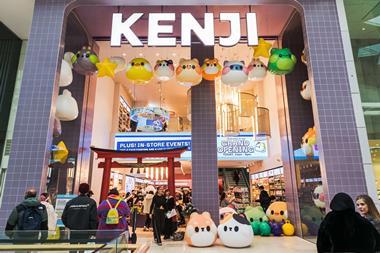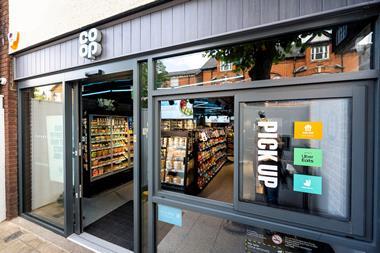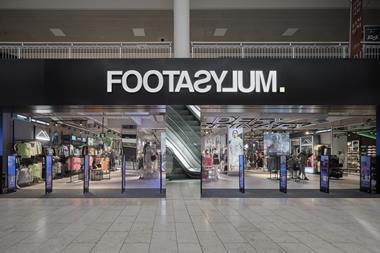If you don’t have a car, Brent Cross shopping centre in north London is quite a difficult place to get to. Arriving at the Tube station bearing the same name, it isn’t too long before you discover that the mall is some way off and the journey on foot will involve crossing the four lanes of automotive misery that is the North Circular.
If you are a student of new retail, however, the trek is probably worth it, if only to take a look at what River Island, that bastion of mid-market fashion, has been up to. It’s now about six weeks since the retailer reopened its store following a four-month closure. Chief executive Richard Bradbury says: “Normally you’d try to keep trading, but there was a lot to do here so we had to close.”
To understand the magnitude of what has been done, a couple of numbers suffice. The square footage of womenswear, which normally forms about two thirds of a River Island offer, has been increased threefold in this branch and menswear, the other third, by about 50 per cent. This kind of space growth does not come easily, particularly in a mature scheme such as Brent Cross, where footage is always under pressure. Size, however, is only one of the aspects that will surprise the store visitor. The two floors, ground and a mezzanine, on the centre’s upper level, cover 10,700 sq ft between them and both have significant differences from what you will see in other branches.
Nevertheless, it would be easy to miss many of these and there is a sense, when walking around the floor with Bradbury, of almost stumbling upon many of them and that the more you look, the more you will see. Bradbury says this is deliberate. “Women don’t like being told what to do when they’re shopping. So we want to surprise them and make their visit enjoyable,” he explains.
Standing on the store’s threshold, there is certainly much that is familiar. There is a table with merchandise laid on it, a galvanised steel lighting rig above it and on either side are exposed brickwork walls, whitewashed and with graffiti on one side and plain brick on the other. As in every other branch of River Island, the retailer has resisted the temptation to put the staircase in the middle of the shop, a trait that seems to define many fashion retail interiors. Instead, it is set against the wall, on the right-hand side in this instance. Bradbury says that a centre-floor staircase or escalator has been considered on many occasions. “But when it comes to it, we just can’t push the button,” he says.
Perhaps it’s just as well that an exception has not been made at Brent Cross as this would run the risk of spoiling a pretty symmetrical interior that makes dividing up the space and creating good in-store navigation more straightforward.
So what exactly is different about this store from any other? “Everything’s a bit clearer and it’s a bit emptier,” says Bradbury. “There are more materials and more textures.” The table at the entrance is the first example of this. Rather than going for a mass-produced, off-the-peg piece of shop equipment, Bradbury’s team has gone out and sourced second-hand furniture.
The messaging on the brick wall is also subtly different in terms of font and finish from what can be found elsewhere. Beyond this there is a black glass section of wall panelling, which Bradbury points at. “The problem for us is that when you have quality finishes, you have to ask what you can do to move them forward,” he says. The answer in the case of the black wall is nothing. But there is a buttress directly in front of it, the lower parts of which have been hollowed out and shelves inserted within it. Bradbury draws attention to the fact that this niche has been lined with attention-grabbing wallpaper. Opposite this and just under the stairs, there is a dressing table painted with a leopard skin design. “We could have sold loads of these,” says Bradbury. The reason that he has not, he explains, is that this would involve storage in a store where space is at a premium. There is also the little matter that River Island is about fashion rather than furniture.
Look up from here and there is a void before the mezzanine kicks in, where the ceiling becomes lower. The void has been used to good effect, with an outsize abstract graphic of a New York cityscape on one of its walls demanding that you glance up towards the mezzanine level. As you do so, you realise that as well as a graphic, the largest of its kind in River Island according to Bradbury, there is also a gantry on which mannequins have been positioned.
Not so long ago, you would have expected mannequins to be positioned voyeur-like on the mezzanine’s balcony acting as spectators to the action on the ground floor. No longer. Bradbury says it’s a feature that has been widely copied and therefore it’s time to move on.
Accessorising store features
Back on the ground floor, an open-sided steel and glass “spine” divides the initial area underneath the mezzanine. “We could have blocked this in, but decided that it’s better to let people see through it and into other areas,” says Bradbury. Beyond this, on the left-hand wall, is the cash desk. This features grey floral anaglypta wallpaper, grey tiles (mirroring the finish on the floor) and black pendant lights from designer Tom Dixon – the man responsible for many of the products that Habitat shoppers will know. Floral patterned anaglypta wallpaper is used across all of this floor, adding interest to pillars and walls.
At the rear is an Accessories Boutique with a marginally lowered ceiling, acting as a semi-separate shop-in-shop for a category that Bradbury says is one of the store’s most important. Beyond this, and to the left, are the fitting rooms. Bradbury seems excited, describing this part of the shop as “probably the thing that’s newest”. Each fitting room has a portal with a cartoon front door painted across its entrance.
These are brightly coloured and there is a large waiting area so that women can try things on and get the opinion of their friends without having to come out onto the main floor.
Head upstairs and it’s menswear. Bradbury says that this is one of the “tougher” parts of the fashion business at the moment because, given alternatives of “spending an extra£15 on filling up your car or going to a match, what are you going to do?” Nonetheless, it is clear that as much thought has gone into the linear layout of this floor as to the more organic form downstairs.
The most obvious and eye-catching feature is the cash desk. It is backed by an Art Deco-style coffered design that has been sprayed silver. It’s the kind of thing that you used to see on the ceiling of your local Odeon and, indeed, in the new Oxford Circus branch that opens later this month, it is being used to form the shop’s ceiling. Elsewhere, menswear is divided along fairly traditional lines with a jeans shop, a casual area and a discrete formal department. In the latter, retro kitsch is deployed in the form of large wall-clocks of the type reminiscent of 1970s offices.
Bradbury says that it’s difficult to say how long this store took to put together because his internal design team and a representative from River Island’s long-serving external design consultancy, Dalziel + Pow, meet every Monday to thrash out the latest developments. He does add, however, that, for the moment at least, this is as good as it gets and that many of the features will be used in other stores. Once more, River Island appears, in many ways, to be a step ahead of its competitors.


























No comments yet